Jovaru Alus
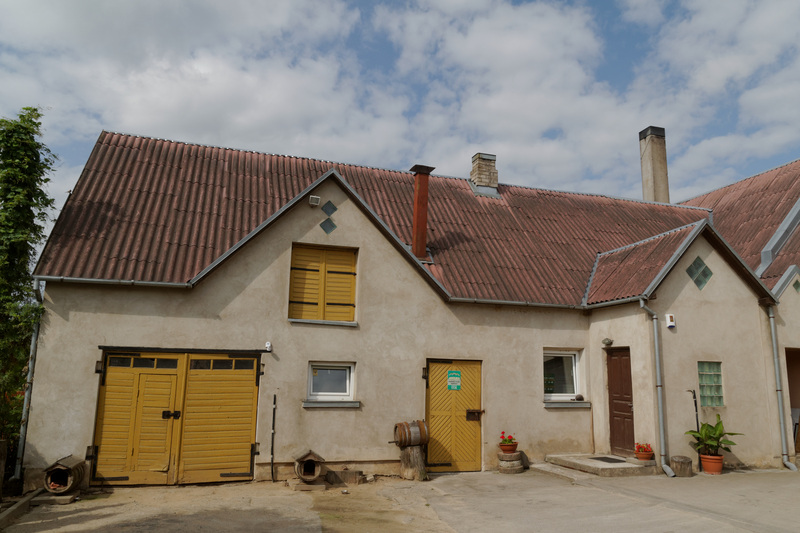
The brewery |
As a favour to me Vidmantas had left the most interesting brewery as the last of the day, so that we could spend more time there. We stopped the car in the yard between the brewery/barn and the house, and got out, to be greeted by angry barking from a tiny little dog tied to a doghouse made from a wooden beer keg. Another dog, looking exactly like it, came to peer at us curiously, but didn't bark. Then the brewer herself, Aldona Udriene, came out of the house to greet us. She immediately explained about the dogs. The one chained up was the "angry dog". He doesn't like visitors, but the other dog was the "good dog," which is never rough with anyone. (This is part 5 of the Lithuanian brewery tour 2015.)
The brewery is called Jovaru Alus because it's in the village of Jovarai, which again is part of the small town of Pakruojis. It's the most famous of the Lithuanian farmhouse breweries, supplying the house beer to the three Šnekutis bars in Vilnius. It's also been featured on foreign TV, in magazine articles, and so on. Locally, the brewer, Aldona Udriene, is known as "the queen of Lithuanian beer," for her regal bearing, and the excellence of her beer.
And the beer really is excellent. In fact, it's not just excellent, but also very different. As you will see.
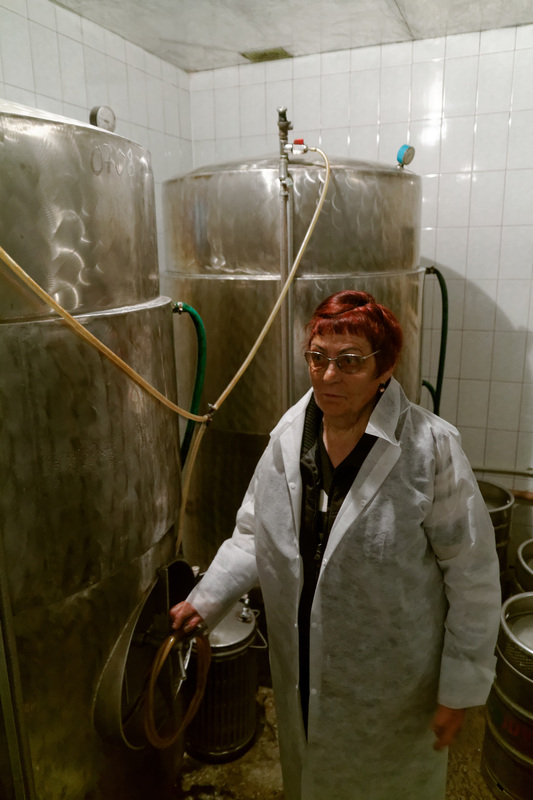
Aldona Udriene in front of the maturation tanks |
She takes us on a quick tour of the brewery. It follows a pattern that by now is becoming quite familiar. There is a wood-fired boiler for heating the brewing liquor (water). The next room has a small mashtun built from an old dairy tank, and next to that again is the maturation tanks. (Note the absence of a boiler.) Finally, there is the fermentation room, where beer is busy fermenting. The foam looks decidedly unusual, with big glassy bubbles on top of more normal-looking foam. There is, of course, a reason for this.
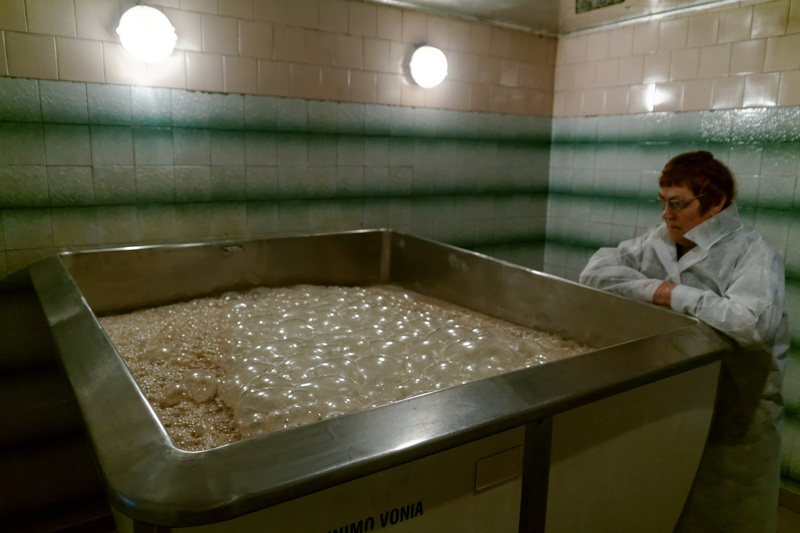
The fermenting beer |
Ms Udriene uses a yeast she got from her grandfather. What kind of yeast it is nobody really knows, but genetic analysis of it gave some very surprising results. What anyone who's had a sip of her beer can tell, however, is that it's a very unusual yeast. It creates aromas that are unlike any other beer I've ever had.
We leave the brewery, and go to the tasting pavilion, where the tables are already set for a large group. I ask why, and she says she has 15 tourists coming tomorrow, and another large group on Monday. There were 190 people visiting all told in June. Most of these people make bookings in advance and bring translators, but not always. Two Americans just knocked on her door one day, and they turned out to speak only English. She makes a face. Clearly she found it awkward to act as host for people she couldn't communicate with.

The beer |
Then a big, foaming glass jug of Jovaru Alus appears on the table. I've been fascinated by this beer for years, and make a point of always drinking at least a pint of it whenever I'm in Lithuania. It's a beer that needs to be drunk fresh, though, and here I'm having it in the brewery, as fresh as could be. Ms Udriene pours me a glass, and it foams so much that it overflows the glass. She smiles, and says "this means it's filled with love."
As usual, the taste is an odd fruity herbal walnut mix, with phenolic, oily notes. In the mouth it's very soft and smooth, almost fluffy. The carbonation is low, but not quite as low as English cask ale. It ends on a dry, herbal, faintly hoppy note, with a peppery, floral backdrop. It's very complex, and yet way too easy to drink for a 6% beer. A favourite beer, and one I love coming back to. I've had it warm, and I've had it cold. I've had it fresh, and not so fresh, and every time I find new facets in the flavours.
I start asking questions, trying to get a sense for where this deeply unusual beer comes from. It turns out that just like Su Puta and Piniavos she started out brewing in wooden equipment, then had local welders build her present brewery, mostly out of old dairy equipment. Apart from the yeast her ingredients are not that unusual: Czech and Lithuanian malts, imported hops. She's very clear that the flavour is mostly from the yeast.

Traditional ceramic beer jug |
Her brewing process, however, is not normal. She starts with a step mash with two steps. First, 75-78C water is mixed with the malts. The mash temperature should be above 65. She says the brewing literature says she should mash at 65, but she's found that if she does that the beer will be too dry. Then she mashes again, at a higher temperature. Then she runs off the wort, and hop tea is added. The wort is cooled, and the yeast is pitched at 29C. She says during fermentation the yeast will bring the temperature up another 2-3 degrees. So this is another raw ale, and clearly she's stuck to the traditional farmhouse process, even if the brewkit is semi-modern.
That it's a raw ale tends to throw people off a bit. It means that the protein from the malts remain in the beer, filling out the body. Many people, even highly experienced drinkers, pick this up, but misinterpret it, and think the beer is sweet. It's not. Canadian homebrewers tasting it found they couldn't agree on whether it was sweet or not, so in the end they measured the final gravity (FG) with a hydrometer, and got 1002.5, which means there's basically no sugar. I made my own measurement last year with a refractometer, and calculating backwards from the 6% ABV on the label, I arrived at an FG of 1.005.
And yet highly experienced tasting experts can write tasting notes that go "Sweet malts, maltsyrup, honeyish. Syrupy, slick², viscous. Pretty awful, and I wonder whether it’s fermented at all?"
It really is an unusual beer.
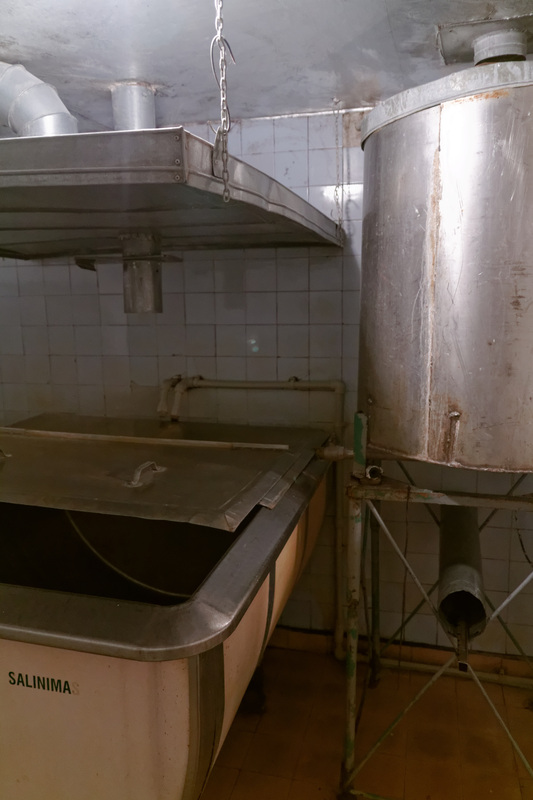
Mashtun, and tank for brewing liquor |
I try asking a bit about her background. She says she learned to brew from her father, and her father learned to brew from her grandfather. The yeast followed the same chain. What happened before her grandfather she doesn't know. Her father 70 years ago was the most famous brewer in Pasvalys, she says, and "people coming to the village would not go first to the church, but to the brewery."
Her father and grandfather both made the malts themselves. They would soak the barley in water, then take it up and leave it to sprout in the sacks so it would remain wet. The shoots and rootlets would be removed by rubbing between the hands (just like at Storli in Norway!) The rubbing was child's work, and she herself started doing it when she was four years old. Her hands would get sweet and sticky, she says.
While Vidmantas is translating I hear her say "senielis" often. I make a guess and ask whether it means "grandfather." Vidmantas nods. She doesn't say it directly, but it's clear that brewing in the tradition, keeping things close to how grandfather did it, is very important to her.

Deer skulls, from the tasting room on top of the brewery |
Suddenly, she says, "now, let's talk about yeast," guessing what's been on my mind the whole time. In the old days, she says, people would store their yeast through the winter by putting it in a jar and burying it about 1.2 meters in the earth. They might also dry some next to the fireplace and keep that as a backup. In summer it might be stored with ice taken from the river in winter, sprinkled with straw and sawdust, then covered with sand. In this way it could last from brew to brew (she's implying people didn't brew very often).
I ask if she's ever had problems with her beer going sour, and she says in the first years (late 90s) this happened sometimes. The worst time was in August, around the time the apples ripen. She has reserve copies of the yeast to guard against this kind of thing, and she can also regrow the yeast from bottled beer. At one point the infection problem got so bad, she tried to solve it by switching to lab yeast. That didn't help, she says. The only thing that helped was more cleanliness. (I guess this explains the distinctly un-farmhousey white coats we had to wear in the brewery.)
I ask her what people would do in the old days if the yeast went bad, and she says in the Pasvalys region people wouldn't share their yeast. "You cannot spread your yeast," was a local saying. But if it was necessary, because the neighbour really didn't have any yeast, then people would share.
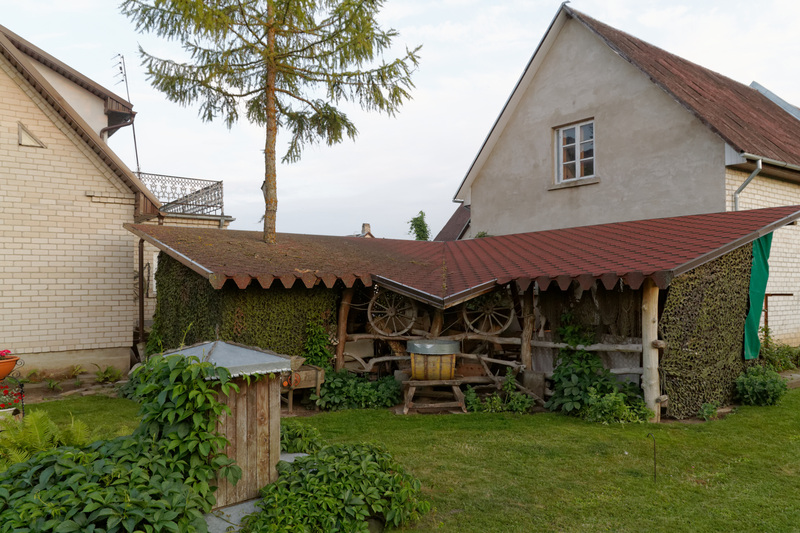
The tasting pavilion |
Apparently she doesn't sell as much beer in the local area any more, because there is more competition there now. I stupidly forgot to ask what competition this was. Probably 80% of her production is sold in Vilnius and the other cities. She says mostly students drink her beer, so that makes it hard to sell in the summer, because then the students are away. Personally, I think this is very encouraging. If Lithuanian students are drinking Lithuanian farmhouse ale there's hope for the true Lithuanian beer still.
It gets dark, and ms Udriene notices I have difficulty seeing what I'm writing. So we go into the house and continue talking. All the while she keeps urging me to drink her beer, but of course no urging is really necessary. Some hours later we start thinking of the tour ahead of us the next day, and make our goodbyes before leaving the house. Vidmantas and I stumble down a tree-lined avenue in the darkness, heading for our motel in Pakruojis. I'm drunk, but happy. A long-awaited personal pilgrimage has finally been completed.
Similar posts
Hunting Lithuanian white whales
On the morning of the second day of the Lithuanian brewery tour 2015 we stopped by a small and little-known brewery called A
Read | 2016-09-28 14:54
Kupiškio - underground brewers
Eventually we ran out of breweries to visit in Pakruojis, and started discussing where to go next
Read | 2016-09-11 13:41
Comments
Alec Latham - 2016-08-21 11:10:27
I really love these posts as they're different to anything else beery being written about. It's like David Attenborough showing us footage of some completely new creatures. Keep up the good work. Do you think you might publish these Norwegian & Lithuanian road trips in book form some day?
Lars Marius Garshol - 2016-08-21 11:22:44
@Alec: Thank you, that's very kind. :)
The Norwegian road trips, together with some more in-depth historical background, will be published in Norwegian in about a month. See the "My new book" thing in the left column. We finally finished it completely Monday this week.
I've done a *lot* more travelling and research than what's evident from the blog, and clearly that does need to be published in book form. I just haven't figured out how yet. We'll see.
Ben F - 2016-08-21 18:14:02
All your blog posts on raw ale and Lithuanian beer has been eye opening for me. Just when you think you are well educated and had most styles of beer at least once...a whole new huge style opens up.
What I hope for most is people notice this around the world and they start getting international distribution also American craft breweries start picking up on raw ale. I could see this style being really popular with local neighborhood breweries that are popping up everywhere in the states! Especially since sours are becoming very respected here.
Keep up the fantastic work.
Peter Wolfe - 2016-08-21 20:17:35
Lars, any chance your longer writings (i.e. any books) will also be published in English?
Lars Marius Garshol - 2016-08-22 02:28:19
@Ben F: Thank you! :-)
Exporting raw ale places quite heavy demands on the transport and distribution. I know there are US importers that can handle that, but ... well ... it hasn't worked out yet. There's no reason why it couldn't, though, so perhaps you'll see it some day.
@Peter: Yes, I will publish a book in English eventually. I have an outline, and some idea of the shape of parts of it. But I'm taking it slow, because writing the Norwegian one was really exhausting. So, eventually.
Lee - 2016-08-22 04:46:37
Wonderful write up Lars. I am and have been for a while now,head over heels in love with the idea of this beer. An American guy call Jack something or other,calls himself the booze traveller,visited this brewery and went so far as(I died a little inside) took a few spoons full of this wonderful lady's yeast and ate them,infecting a bowl full of yeast with his own bacteria.
Martynas - 2016-08-23 05:08:18
Lars, I was just thinking about the sweetness of Jovarų beer that some are mentioning. I wonder if it could be because of... honey? Aldona does two beers - the regular, and "su natūraliu medumi" (literally "with honey"), the honey being added after fermentation.
As for the competition, she might be referring to either two breweries in her vicinity (Algio alus on the same street, and Davra on the other side of a lake) or industrial eurolagers (Švyturys-Utenos or Kalbapilis) that all local shops are flooded by.
Lars Marius Garshol - 2016-08-23 06:01:05
@Lee: Thank you! :)
@Martynas: I don't think it's because of the honey. The quoted beer expert put his review under the non-honey beer, and I'm pretty sure he identified it correctly. The Canadians definitely weren't trying the honey beer, because the FG reading of 1002.5 was taken from the beer they were arguing over. Also, I've noticed this myself. My first review described it as "sweetish".
This thing with the competition confuses me, because as far as I can tell nothing's changed with those breweries, but I agree those must be the ones she's referring to.
Joe - 2016-08-23 22:11:46
That angry little dog bit my wife's hand in June when we visited Jovaru with Vidmantas! I wish we'd gotten the same warning from Aldona! The beer was great though...
Joe Stange - 2016-08-29 06:14:35
Great writeup, Lars.
Thanks to your book and blog I had some idea of what to expect when I visited with Vidmantas (Nov 2015). So I also found the beer a bit sweet, but I decided it was a combination of (1) relative lack of bitterness, and (2) the impression of full body from those nutty proteins.
Strange and fascinating stuff. I understand why some people don't get i or like it. Just the same, I look forward to a return visit.
Mika Laitinen - 2016-08-30 00:48:47
Extremely interesting! It is very rare to hear details how farmhouse brewers handle theirs traditional yeasts and how they deal with souring bacteria.
On sweetness of the beer I agree with Joe Stange. If the beer is low on hops (and not sour) it is difficult to avoid sweetness. Once I brewed a kind of saison using yarrow instead of hops. The final gravity was 1.004, but the beer was a tad too sweet for my taste.
Lars Marius Garshol - 2016-08-30 02:47:57
@Joe: Yes, that's my interpretation of the Jovaru taste, as well.
@Mika: If the beer really is 1.004 then I would argue that the beer objectively speaking isn't sweet, and that tasters who claim it's too sweet are misinterpreting the taste. They may be led astray by the lack of bitterness, the fullness of body, or perhaps flavour from the yarrow in your case. Because if there's hardly any sugar in the beer I don't see what should be making the sweet receptors on your tongue fire.
analias - 2016-10-30 02:57:31
While running the risk of starting a flame war, I strongly urge those of you that disagree with the assumption that a beer with a (dodgy hydrometer or homebrew shop refractometer) reading of 1.004 CANNOT be sweet from residual sugars to:
a) re-evaluate the concepts of apparent and real extract. (hint, real extract requires an equation that incorporates the lower than water density reading of ethanol)
b) familiarize yourself with the difference between empirically measured extract levels (i.e refractometers), to that of laboratory grade liquid or anion exchange chromatography of accurately quantifiable extract levels.
https://expertise.hogent.be/files/5497306/Analyse_Belgische_Bieren.pdf
As you will see from the 2nd paper, 7 commercial Belgian strong pale ales had apparent extract levels of 1.005-1.013, real extract levels of 1.018-1.026 AND YET contained wildly varying residual fermentable sugars of 0.6-12 g/l, ALONG with high residual non-fermentable oligo-saccharides levels of 1.016-1.024 plato.
example: Beer A (Achel Blonde 8) has an apparent extract level of 1.005, YET has chromatography measurements of 7g/l residual fermentable sugars and non-fermentable levels of 1.017 plato.
So taking these into account, we can see that a beer that some "people" (i.e. not laboratories) measured to apparent extracts of 1.002 or 1.004, can indeed be highly misleading, especially when their "measurements" were probably of beer that still contained co2.
TL:DR Most beers contain large amounts of residual sugars that are not measured with anything close to accuracy by hydrometers or refractometers and caution should be used when coming to strong conclusions based on such highly empirical measurements..
Matt Glanville - 2017-01-07 18:53:49
it is also important to concider flavour perception as well as just measurements. Flavours like vanilla are often found in sweet foods, adding vanilla flavour (without sugar) to a beer will make it "taste" sweeter even if the amount of sugar is the same.
Similarly if you have two samples of soured beer with the same pH, one with an orange flavour and one without. They will "taste" different levels of tartness as you will associate orange with a level of acidity.
I would love to try some of these beers though!
Adrian Swanson - 2019-03-07 00:14:10
I am interested in homebrewing a beer similar to Jovaru Kaimiskas. Do you have any insights regarding which malts, hops, and techniques would I use? Is the color from a long boil, or from malts darker than pale/pilsner? What is a good bittering target?
Christopher E McGarvey - 2019-03-13 16:48:39
This is a three year old post, so it may be the conversation has already moved on, but just for anyone like myself still reading here, one other comment about sweetness is very much in order.
It is important to remember that fermentable sugars are not the only sweet-tasting compound on earth. It is possible to have a fully attenuated beer with no residual, fermentable sugars that still tastes sweet. One reason for this is the possible presence of alcohol sugars such as glycerol, sorbitol, and others, which are non-fermentable compounds that adds body and taste sweet to the human palate.
Some yeast strains actually produce a considerable amount of alcohol sugars like glycerol as a by-product of fermentation--a fact better known among the wine industry than among brewers. I believe the French Saison strain is one such example, which is why that strain can show very low apparent attenuation, but not leave the beer feeling bone-dry and thin. It really is a pity that brewers pay so little attention to this trait, that it is rarely researched or documented with other technical data given to us by yeast labs-- a practice much more common in the wine industry. And as someone mentioned above about vanilla, the further presence of fruity esters may contribute to the impression of sweetness.
I would not be at all surprised if this Lithuanian yeast strain turned out to be a high producer of alcohol sugars, plus some "sweeter" leaning esters. The combination of esters and actually sweet-tasting alcohol sugars could be more than enough to propel sensory perception into the sweeter end of the spectrum.
Ultimately, the best gauge of sweetness is the human palate, NOT a hydrometer. The tongue is a far more sensitive instrument that measures many compounds that a hydrometer cannot. I do not believe tasters of the Jovaru ale are confusing sweetness with fullness of palate caused by proteins. Rather, they are most likely tasting sweet compounds other than sugar that are present from the brewing process, and are particularly evident in such a low-hopped beer.
Awtas - 2019-04-25 14:29:24
Well.. Almost three years later now home brewers can try this yeast themselves. In US you can buy the Jovaru™ Lithuanian Farmhouse (OYL-033) yeast that is produced by the Omega Yeast.
Donny - 2019-05-26 01:37:56
Hi, just wondering if Jovaru yeast can be dried. The kveik registry says no but in the interview with the brewer she says they sometimes dried it near the fire as a backup.
Nils - 2019-07-21 18:18:09
I brewed a very simple beer with the Omega Labs release of her yeast. The flavor description in your article is implausible and bewildering until you try a beer with this yeast, at which point the description becomes vivid and 100% accurate.